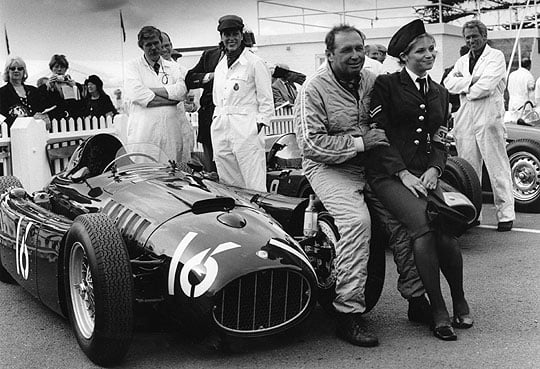
The February 2006 issue of 'Cars for the Connoisseur' magazine features Anthony Maclean’s story of how he instigated the limited-edition run of four ‘recreations’ of the magnificent Lancia D50 Grand Prix car of the mid-1950s.
This is an abridged version of the original that The Editor, Charles Harbord, has generously offered subscribers of Classic Driver a FREE sample. See below for details.
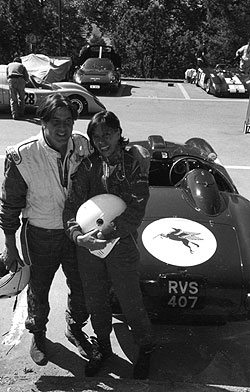 "I suppose my part of the story begins with my father in the late 1950s. He regaled me with tales of an open Lancia Lambda in which he sped round the Leicestershire country lanes before the Second World War. When we went to the Earls Court Motor Show we always made out first stop the Lancia stand. I still remember being thrilled to see the Flaminia Zagato and admiring a Flaminia Touring convertible when we were on a family holiday in Switzerland.
"I suppose my part of the story begins with my father in the late 1950s. He regaled me with tales of an open Lancia Lambda in which he sped round the Leicestershire country lanes before the Second World War. When we went to the Earls Court Motor Show we always made out first stop the Lancia stand. I still remember being thrilled to see the Flaminia Zagato and admiring a Flaminia Touring convertible when we were on a family holiday in Switzerland.
"When [my] finances had slightly improved I came across an almost new and perfect 2.8 Flaminia Touring convertible which I used daily and kept for nearly 20 years. What I really wanted was a more sporting and earlier Lancia from the great days of Lancia racing in the mid ‘50s. In 1979 I eventually found in Chicago the Aurelia Spyder which I still own, which was supplied new to Cuba on the eve of the Revolution. The Spyder was joined in around 1990 by a wonderful D24 recreation, painstakingly carried out in Turin by Guido Rosani and Luciano Basso - this was the car which was to set me on the road to meeting Guido and the D50 project.
"Work on the car was started by dear old Almo Bosato, the doyen of Turin tuners, now sadly dead. Almo introduced me to Guido, who told me the story of how he and Luciano Basso had recreated the D24. Guido was on hand as a small boy in Turin to see the D24s [that had won outright the Mille Miglia (Ascari) the Targa Florio (Taruffi) and the Carrera PanAmericana (a clean sweep with Fangio, Taruffi and Castellotti first, second and third) - Ed] pushed away into retirement in a corner of the racing department after their season of glory so that work could concentrate on a yet more ambitious project - the D50 Grand Prix car.
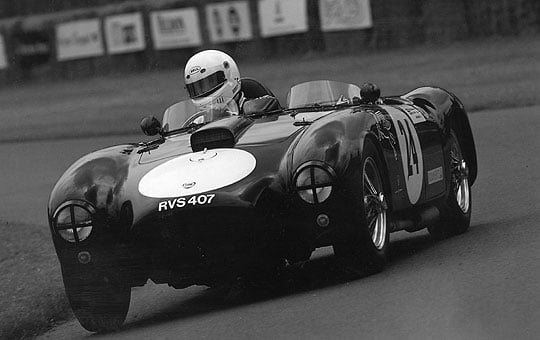
"Revolutionary in so many ways (V8 engine as a stressed member of the chassis, twin outboard fuel tanks to smooth the air flow between the wheels as well as to equalise weight distribution, angled prop shaft to lower the driver’s seating position and the centre of gravity and many other firsts) the D50 was quite unlike any other front engined Grand Prix car of the ‘50s and was the only car to rival the Mercedes W196. The death of Ascari in 1955 and the expense of the hectic development of the D24 and D50 regardless of cost led to the closing of Lancia’s racing department and to the sad hand over of the D50s to Ferrari.
"Fast forward now to one evening in Turin in 1994 when Guido and I meet at his house. Shyly, he asked me if I would like to see ‘something interesting’ in his garage at the bottom of the garden. The ‘something interesting’ turns out to be a D50 chassis which Guido has painstakingly built himself, complete with an original D50 engine. It turns out that Guido has - much else besides - a complete set of D50 drawings, much technical data including dyno reports and spidery hand written race reports as well as Ascari’s contract with Lancia. But he is missing the vital and intricate transaxle, so beautifully conceived and engineered that it survived through to the Ferrari 312 PB.
"He tells me that he has written many times to an Englishman - Anthony Bamford - who has several original transaxles but that he has never had a reply. I promise Guido that I will see what I can do to help. The germ of an idea begins to form. Perhaps, if Anthony Bamford is prepared to help, we can build several cars and sell one or two to finance what will obviously be a very expensive project?
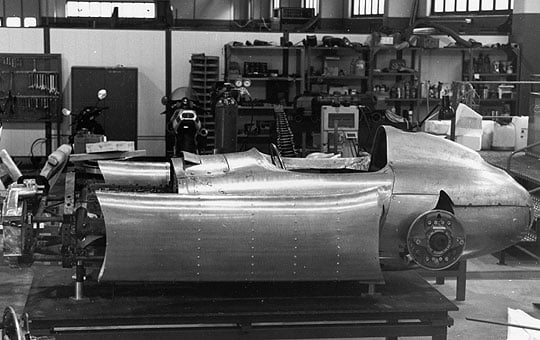
"A meeting is arranged in Staffordshire between Guido, Robert Brooks, Anthony Bamford and myself. As a precaution and unannounced I have arranged to bring my D24 in a transporter to the JCB works. The D24 is sprung from the transporter and we go for a short drive round the Staffordshire lanes. Anthony is won over to the point where he wonders whether the D24 might not be more fun and more exciting than his nearby GTO.
"Guido, Anthony Bamford and I agreed that the cars would be built in Turin and then shipped to England where Jim Stokes would rebuild the engines and transaxles and prepare the cars to be race worthy. Guido’s friends and fellow Lancisti in Turin all volunteered to help. His old friend Giancarlo Giannetti provided Guido with a corner of his magnificent machine shop on the outskirts of Turin which makes parts for Italian Formula One and rally teams; his factory also agreed to make the complicated and sophisticated parts which we would need for the intricate suspension, steering and braking systems. All of a sudden we had at our disposal one of the best machine shops in Italy and the perfect workplace with every type of facility and tool we could possibly need.
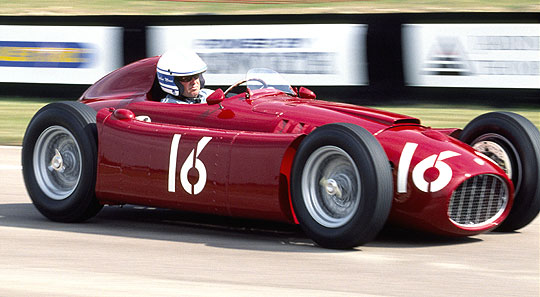
"Borrani agreed to supply wheels and hubs to the original pattern. Allemano which had made the instruments for the D24 and the D50 in the 1950s and was still in business agreed to help, [while] the Fiat Lancia Museum very kindly allowed Guido to dismantle one of the two surviving original D50s to check details and measure dimensions. Ercole Spada, retired chief stylist at Zagato, helped Guido with body drawings and designs as well as the buck. Manfredi Lancia, long-term friend of Guido’s and now owner of my Aprilia, helped and encouraged throughout and willingly set to work on assembling and polishing the aluminium and wood steering wheels built in exactly the same way as the originals. Various additional items came to light.
"Nigel Trow, Lancista, professional photographer and writer of Lancia books, took wonderful photographs for us of the transaxles, engines and other parts as they were unearthed, including a wonderful black and white photograph of Guido looking for all the world like a 1950s ingegnere in the Lancia racing department beside a complete engine with a factory drawing behind him pinned to the drawing board.
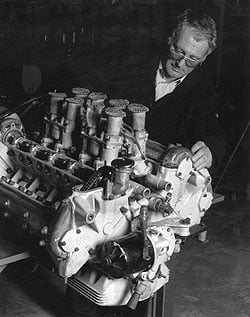 "We were short of two engines and three buyers - neither easy to find but the engines presenting the bigger problem of the two. In the way that can only happen in Italy two engines (probably the only two in the world, apart from the ones we already had) surfaced within a few months, we were [then] given the address of an elderly collector in Bergamo who was also thought to have a D50 engine.
"We were short of two engines and three buyers - neither easy to find but the engines presenting the bigger problem of the two. In the way that can only happen in Italy two engines (probably the only two in the world, apart from the ones we already had) surfaced within a few months, we were [then] given the address of an elderly collector in Bergamo who was also thought to have a D50 engine.
"Guido went to see him and was told that Gianni Lancia had indeed given him an engine in 1955 to install in a power boat. There it was, still in its Lancia Corse wooden packing crate complete with magnetos, carburettors and ancillaries and with the June 1955 dyno tags. When carefully disassembled by Guido and Jim in Turin it turned out to be a new and virtually unused engine perfect in every respect.
"I talked to a number of possible buyers without success. On the off chance I rang up Tom Wheatcroft who said that he and his son had been discussing building a D50 only a few months before. I went to see Tom at Donington and we shook hands on a deal after a short chat. I had tried through various intermediaries to see if Bernie Ecclestone might be interested in a car but was repeatedly told that it was very difficult to talk to him or get his attention. Fortune favours the brave, so I called Bernie one day, unknown and out of the blue. We met at 8 o’clock the next morning and agreed a deal, again on a hand shake. Tom and Bernie were both wonderful supporters of the project throughout, stoically putting up with various delays and setbacks; we kept faithfully to our side of the deal on price despite problems on a scale we had never anticipated. A little later we agreed a deal with Robin Lodge who wanted to be the guinea pig and have the first car completed.
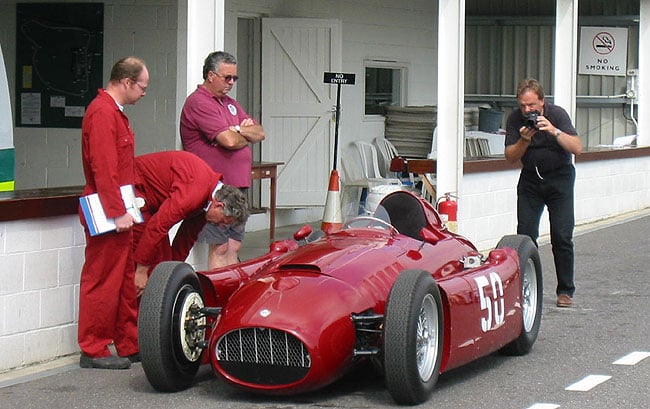
"Many visits to Turin followed over the coming months and even years culminating in seeing the first car beautifully bodied and painted in the correct dark Lancia maroon soon to be shipped to Jim Stokes in England. Jim painstakingly disassembled the chassis and checked, X-rayed and crack tested every item. He then rebuilt the car to race standards and re-assembled the engines and transaxles. The transaxles needed hardly any attention apart from new bearings as a precaution. The engine had new pistons, rods and crankshafts, both for reliability and to save the unthinkable risk of damaging an original block or head. Everything was rebuilt to the original specification with very much the same methods as would have been used in the 1950s. On the dyno, the engines gave almost exactly the same output as Lancia had obtained, varying between about 220 and 230bhp. After minor adjustments, mainly for handling balance, the cars turned out to be race worthy and reliable as built.
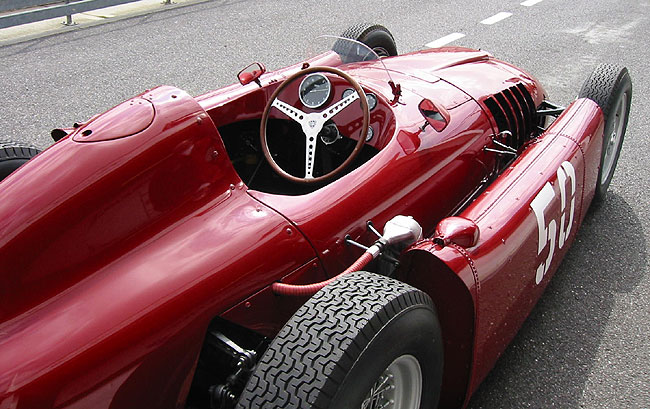
"There has been a little gentle development over the last two years. Tired of seeing the 250Fs disappear into the distance my car has now been developed to run on methanol and has had improvements made to the handling. Last year at the Revival in the expert hands of Jochen Mass it finished comfortably in front of all the 250Fs, apart from the much later TecMec car which Jochen had in his sights during the closing laps. Everything else of the same age was well behind.
"I think it’s fair to say that the magnificent efforts of Guido, his friends and helpers in Turin and of Jim Stokes and his team have met with almost universal approval as well as sparking off a lively debate about reconstructions of which we will no doubt hear more. It has been observed that our D50s contain more original parts and are closer to the original specification than most of the 250Fs out there. At least spectators have now seen and enjoyed the sight and spectacle of the extraordinary D24 and D50 - rare tool room creations built regardless of cost and recreated very much in the same spirit by people with direct links with Lancia’s glory days of the mid-1950s."
All text and photographs - STRICTLY COPYRIGHT
Words - Anthony Maclean
Photographs - Nick Louden/Roger Dixon/Classic Driver/Cars for the Connoisseur
The Editor, Charles Harbord, has generously offered subscribers of Classic Driver a FREE sample of the February issue. Those interested should telephone his 24 hour hotline : +44(0)1747 830 755
Or e-mail him at: [email protected] - mentioning classicdriver.com.
For further details on how to subscribe to ‘Cars for the Connoisseur’ please CLICK HERE
Jim Stokes' website can be found HERE.
ClassicInside - The Classic Driver Newsletter
Free Subscription!









